Acer Aspire S5 Ultrabook Review: The Steady March of Progress
by Dustin Sklavos on July 9, 2012 7:40 PM ESTSystem Performance
The Intel Core i7-3517U is the second fastest ultrabook processor Intel offers, behind the i7-3667U capable of going all the way to 3.2GHz on a single core. That, coupled with the pair of 128GB SSDs in striped RAID, should allow the Acer Aspire S5 to produce some fairly impressive performance numbers. Intel's HD 4000 graphics are also finally capable of DirectX 11, allowing us to run 3DMark11 and produce comparison results with slightly heavier ultraportable gaming systems.

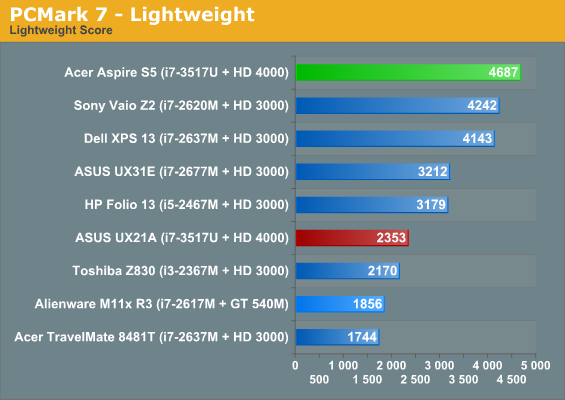
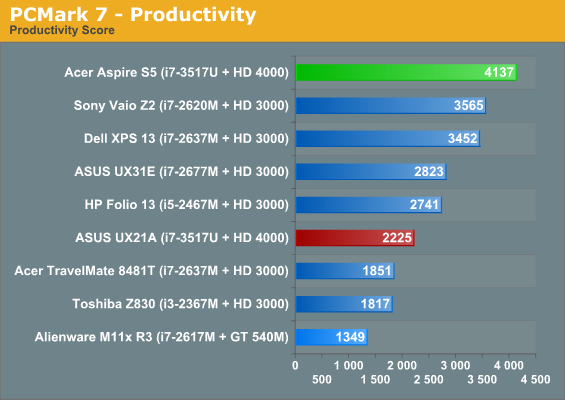
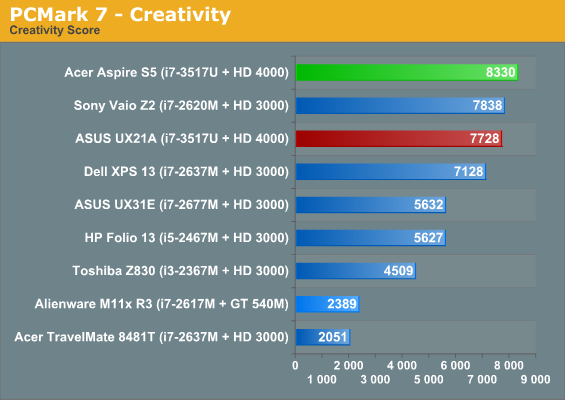
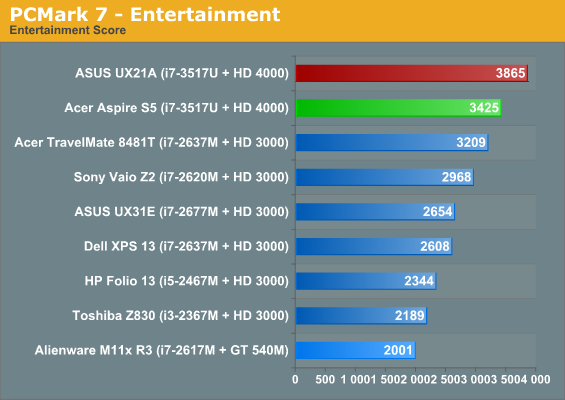
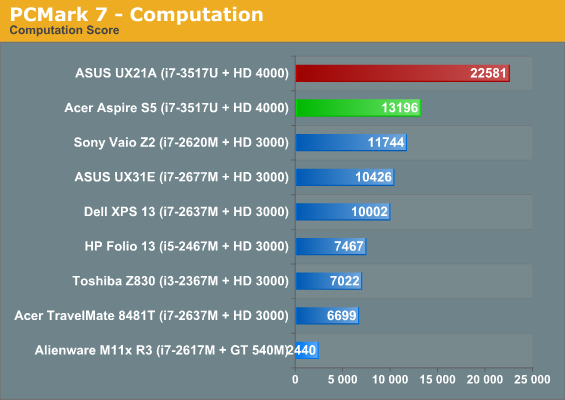
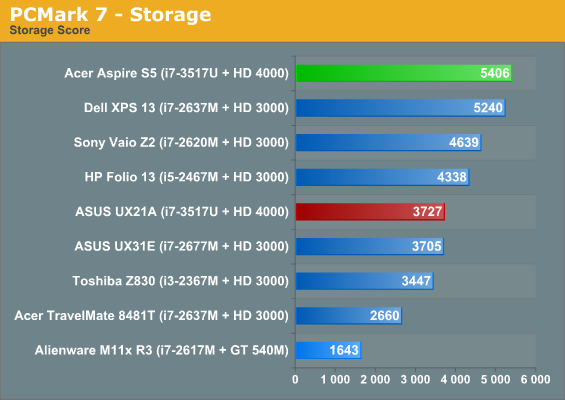
For the most part, the SSD solution in Acer's notebook does indeed seem to be the fastest we've yet tested. That gives it a slight edge against the otherwise comparable ASUS Zenbook Prime UX21A. For reference, even in Microsoft's Performance Advisor, the striped SSD maxes out the score at 7.9.
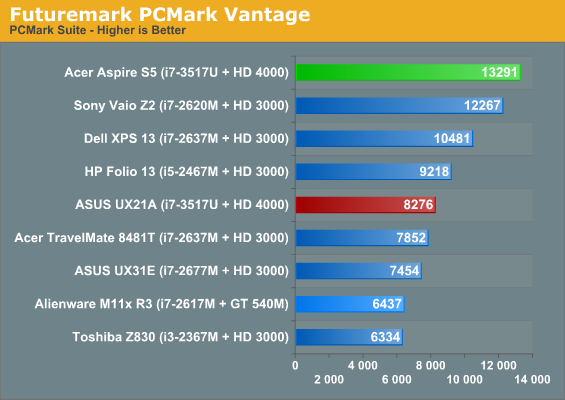
PCMark Vantage tells the same story, favoring faster SSD solutions against virtually anything else.
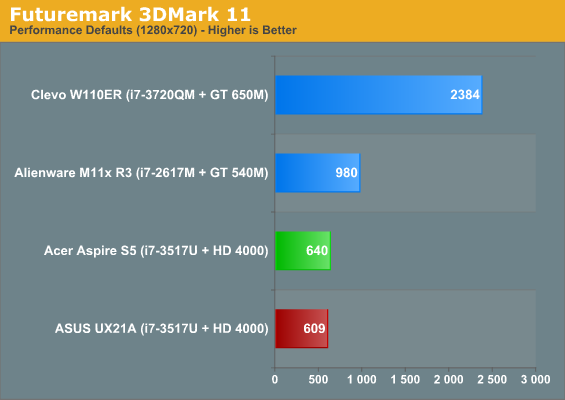
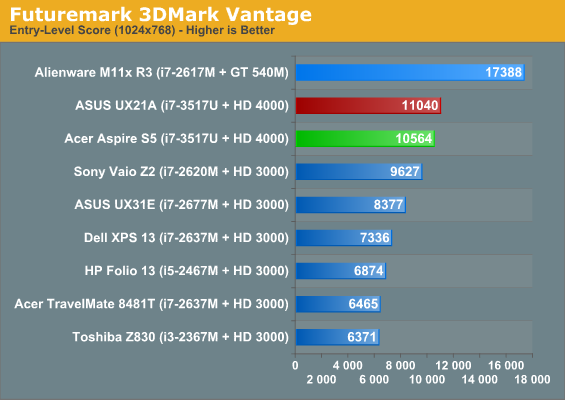

Unfortunately, 3DMark performance remains less than impressive. Pay attention to 3DMarks Vantage and 06 in particular; the faster, standard-voltage CPU in the Sony Vaio Z2 gives the last generation HD 3000 more breathing room and allows it to outperform the otherwise substantially faster HD 4000 graphics core.

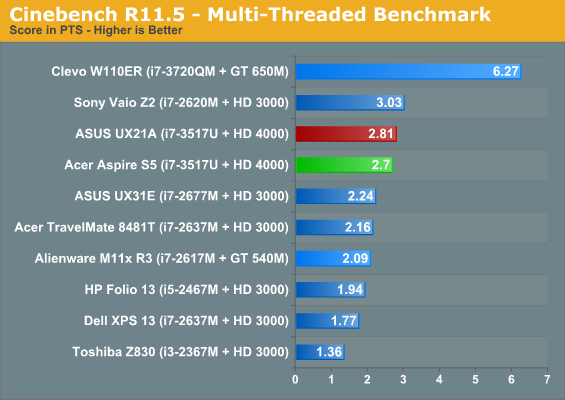
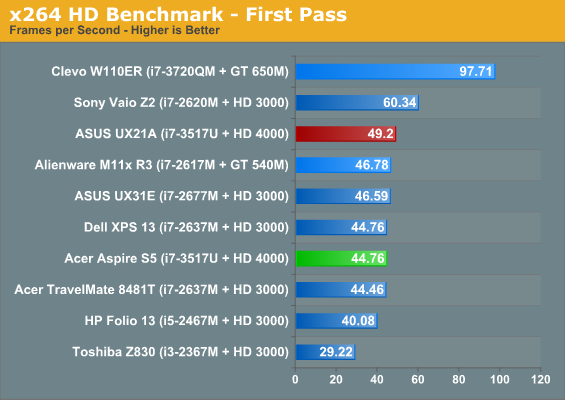
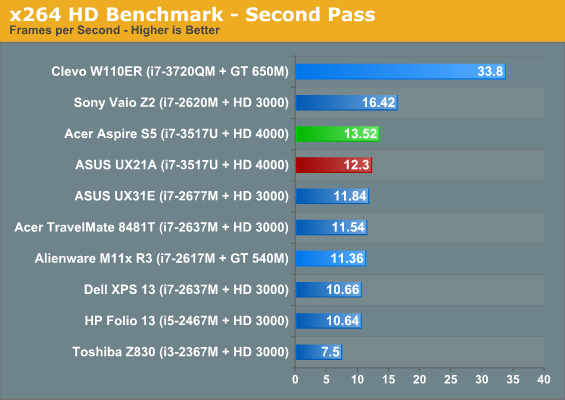
More fundamental CPU performance is about where it ought to be. The S5 and ASUS UX21A tend to trade blows, and I suspect this largely has to do with how each notebook manages its own thermals. For testing, the trap door of the S5 wound up being open the entire time, allowing the S5 to run its processor a little harder.










82 Comments
View All Comments
magreen - Tuesday, July 10, 2012 - link
agree 100%.anyone for going back to the Atari 2600's 160x192 5:6 resolution for the next premium laptop?
seapeople - Tuesday, July 10, 2012 - link
The next step for Asus is to cut out the USB 3.0 and include USB 1.1 instead and subsequently cut the laptop price from $1400 to $1397.Mumrik - Wednesday, July 11, 2012 - link
You mean Acer I hope...frakkel - Tuesday, July 10, 2012 - link
Completely agree that the screen is an important factor. But as far as I have understood Anandtech first calibrate the screens before comparing to each other. How many ordinary people does this?To have a 200 dollar screen that is not calibrated is in my opinion the same deal braker as havíng a 50 dollar screen which is also not calibrated.
As long as you have to do the calibration by your self it simple does nok make that much of a difference if the manucture put in a 200 or a 50 dollar screen. The color accuracy of a non calibrated 200 dollar screen is still terrible. And since most people dont do the calibration I understand why Acer put in thís mediocre screen.
Impulses - Tuesday, July 10, 2012 - link
Color accuracy is the worst of their problems... ASUS' UX31 is cheaper and has a higher res 1080p display that gives you a larger work space. Not only that, its an IPS display with superb viewing angles that dont wash the display out when viewed off center, and like when the guy in the plane seat in front of you decides to recline all the way and your own seat is busted.Impulses - Tuesday, July 10, 2012 - link
The least of their problems rather...JarredWalton - Tuesday, July 10, 2012 - link
Not to mention the contrast. Your brain will basically interpolate so that even if the color accuracy is off, it's "okay" for most people (look at all the tablets that are >10 dE and have no way to calibrate, and some are 50+ dE). For laptops, I think the relative cheapness of the display is easy to determine by looking at where it falls in the following list. (Note that matte vs. glossy is essentially a separate issue; you can have bad matte screens just as easily as bad glossy screens, though I continue to prefer matte over glossy.)[Worst]
Low contrast, low resolution (DPI)
Low contrast, higher resolution (DPI)
High contrast, lower DPI
High contrast, higher DPI
High contrast, higher DPI, better color gamut
High contrast, higher DPI, better color gamut, non-TN
[Best]
Generally speaking, there really aren't any non-TN displays with good characteristics that are still low-resolution, which is good as the last thing we need is 1366x768 IPS displays shoved into 13.3" and larger laptops.
Steveymoo - Tuesday, July 10, 2012 - link
I mean, seriously? They're so damned expensive for what they are!!They're under-performing, 99% of them have terrible screens, and the only practical use I can think of for them, is general office productivity, and internet browsing... Sure they do that pretty well, but why would a company pay over the odds for what is essentially a collection of cheap components, in an expensive (albeit slim,) package.
mrdude - Tuesday, July 10, 2012 - link
It seems that every time I read an ultrabook review I see the same things being uttered: crappy display, not-so-great battery life, too expensive and way way too hot. The form factor is far too thin given the heat output of the processors at 17W TDP and that's not going to change as Haswell will have the same TDP. The components themselves cost more due to the nature of the design and the margins for ultrabook makers is actually below 7%! No wonder the displays are so damn crappy. Even given that super inflated price tag, Acer is almost certainly penny-pinching to barely break even.Why in the world would I want one? Why in the world is Intel pushing these? You can grab a Toshiba Portege with an equally crappy display and have none of the heat issues, better battery life, swappable components, much better performance and all this at the same weight as an ultrabook. The TimelineU M5 seems like a much better format considering the size but even for that thick a laptop (compared to this), Acer had to use a ULV i5 rather than a regular 35W chip and even that laptop suffers from heat and throttling issues (an important point that gets overlooked in every Anandtech review... Can you guys please start checking for throttling during gaming and heavy CPU/GPU work?)
Something needs to change. Either Intel needs to loosen the requirements or tighten them even further. As I see ultrabooks today, they're stuck in some sort of halfway super-portable laptop that just doesn't make sense given the drawbacks and the just-as-portable-but-not-crappy alternatives.
Impulses - Tuesday, July 10, 2012 - link
So you skipped both Zenbook articles?